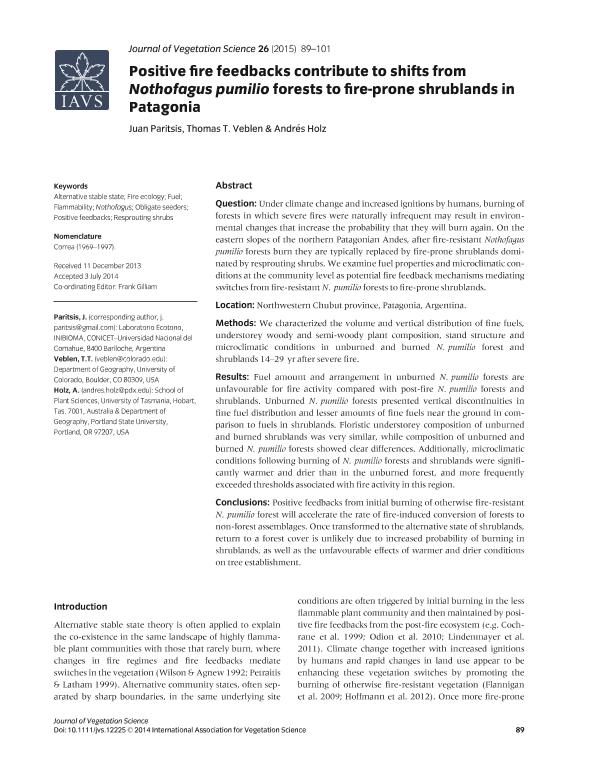Artículo
Positive fire feedbacks contribute to shifts from Nothofagus pumilio forests to fire-prone shrublands in Patagonia
Fecha de publicación:
01/2015
Editorial:
Wiley Blackwell Publishing, Inc
Revista:
Journal Of Vegetation Science
e-ISSN:
1654-1103
Idioma:
Inglés
Tipo de recurso:
Artículo publicado
Clasificación temática:
Resumen
Question: Under climate change and increased ignitions by humans, burning of forests in which severe fires were naturally infrequent may result in environmental changes that increase the probability that they will burn again. On the eastern slopes of the northern Patagonian Andes, after fire-resistant Nothofagus pumilio forests burn they are typically replaced by fire-prone shrublands dominated by resprouting shrubs. We examine fuel properties and microclimatic conditions at the community level as potential fire feedback mechanisms mediating switches from fire-resistant N. pumilio forests to fire-prone shrublands.
Location: Northwestern Chubut province, Patagonia, Argentina.
Methods: We characterized the volume and vertical distribution of fine fuels, understorey woody and semi-woody plant composition, stand structure and microclimatic conditions in unburned and burned N. pumilio forest and shrublands 14–29 yr after severe fire.
Results: Fuel amount and arrangement in unburned N. pumilio forests are unfavourable for fire activity compared with post-fire N. pumilio forests and shrublands. Unburned N. pumilio forests presented vertical discontinuities in fine fuel distribution and lesser amounts of fine fuels near the ground in comparison to fuels in shrublands. Floristic understorey composition of unburned and burned shrublands was very similar, while composition of unburned and burned N. pumilio forests showed clear differences. Additionally, microclimatic conditions following burning of N. pumilio forests and shrublands were signifi- cantly warmer and drier than in the unburned forest, and more frequently exceeded thresholds associated with fire activity in this region.
Conclusions: Positive feedbacks from initial burning of otherwise fire-resistant N. pumilio forest will accelerate the rate of fire-induced conversion of forests to non-forest assemblages. Once transformed to the alternative state of shrublands, return to a forest cover is unlikely due to increased probability of burning in shrublands, as well as the unfavourable effects of warmer and drier conditions on tree establishment.
Palabras clave:
Estados Estables Alternativos
,
Ecologia del Fuego
,
Combustibles
,
Nothofagus
Archivos asociados
Licencia
Identificadores
Colecciones
Articulos(INIBIOMA)
Articulos de INST. DE INVEST.EN BIODIVERSIDAD Y MEDIOAMBIENTE
Articulos de INST. DE INVEST.EN BIODIVERSIDAD Y MEDIOAMBIENTE
Citación
Paritsis, Juan; Veblen, Thomas T.; Holz, Andrés; Positive fire feedbacks contribute to shifts from Nothofagus pumilio forests to fire-prone shrublands in Patagonia; Wiley Blackwell Publishing, Inc; Journal Of Vegetation Science; 26; 1; 1-2015; 89-101
Compartir
Altmétricas




